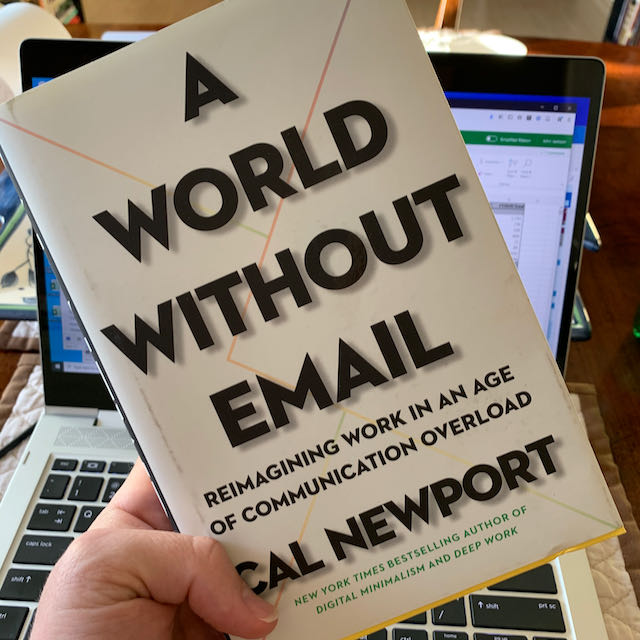I have always been a productivity nerd. When I was in junior high, my father would buy books on cassette by authors such as Stephen Covey to listen to on his daily commute and, at some point, I started listening to them as well. I had a Franklin Day Planner in high school. And as I’ve pointed out before, I have long been a practitioner of David Allen’s GTD.
So when Cal Newport’s new book project was announced, I immediately pre-ordered the book. Newport’s approach to productivity is one evolutionary step beyond Covey and Allen. It’s less about how much you get done or how you prioritize your tasks, and more about how you create the space and attention for doing your work.
As the title of his book implies, email is the villain of the work (or our work). It’s important to point out here the somewhat click-baity title. It’s not just email, it’s also Slack, Teams, IMs, text messages, meeting requests, and all the various unstructured, unsolicited communications that come our way at breakneck speeds every day.
The hyperactive hive mind and distraction
To understand why email et al. is so detrimental, Newport asks that we accept two premises: (1) that context/attention switching hurts productivity and creativity; and (2) that the “hyperactive hive mind” is the default mode of internal communication for most workplaces today (though, as he shows later, it is neither inevitable nor the best way to work).
The hyperactive hive mind, another key character in the narrative, is defined as “a workflow centered around ongoing conversation fueled by unstructured and unscheduled messages delivered through digital communication tools like email and instant messenger services” (xvii). You need an answer to something? Send that person an email. You need an update on the status of a project? Send a Slack message. Need to schedule a meeting? Send several back and forth emails. Unstructured, unsolicited, unplanned.
The problems with this mode of operating are numerous, as Newport spends much of the first half of the book detailing. For one, it produces anxiety: frequent context switching between tasks, emails, and IMs never allows the brain to fully feel as if a project is completed. There is a mental residue that lingers every time you switch from a project, to an email request, back to a project, to a meeting invite, and so on.
Conversely, long stretches of focused, uninterrupted work allow you to mentally “move on” from one project and make it easier for you to give your full attention to the next. The ability for anyone to email you at any time, regardless of how full your plate may already be or the amount of attention you have available to give makes it impossible to properly focus on doing the work you’ve been hired to do.
This frenetic approach to professional collaboration generates messages faster than you can keep up […] and while you’re at home at night, or over the weekend, or on vacation, you cannot escape the awareness that the missives in your inbox are piling ever thicker in your absence. (p. 43)
With longer stretches of attention, projects will be completed faster and more creatively.
Email/IM is too easy and too frictionless, leading to increased work that would not be necessary with more intentional, careful project management. Asynchronous communication is not more efficient, and it does not scale up against either human biology or the fact that time actually exists (and is not infinite!). We shouldn’t be trying to do things faster, we should be trying to do them better.
Our lack of pre-defined processes for how we do our work, what Newport calls “just rocking and rolling with email,” is not nimbleness: it’s just laziness on the part of managers, directors, and organizational leaders. (Note: As others have pointed out, in most cases, burnout is more likely to be a symptom of failed organizational leadership and not an individual’s inability to manage their work.)
A key takeaway from Newport’s book is understanding the difference between workflow and work execution. Talking about work (which is what usually happens over email and IMs) is not work. We need to create processes that reduce context-switching and the need for constant asynchronous back and forth communications. A project management approach to daily processes would allow us to spend less time talking about creating something, and actually creating something.
“If you design workflows that allow knowledge workers to spend most of their time focusing without distraction on the activities for which they’re trained, you’ll produce more total value that if you instead require these same workers to diffuse their attention among many different activities.” (p. 226)
I’ve only touched on a fraction of Newport’s recommendations and the ones that were most salient for me. I highly recommend checking it out or purchasing a copy for yourself.

New practices to try out
I can’t change how others work outside of my own team, but I can change how I process their expectations of how I should work. And perhaps, in doing so, I can encourage others to adopt similar practices. So here are a few practices detailed in Newport’s book that I would like to try and implement.
Office Hours: This is the most radical of the ideas presented that I feel I could adopt. One of the arguments against reducing a team’s reliance on email is “But how will I get your attention when I need you!?” One solution is to set up open office hours: a standing, weekly time when you make yourself available in-person or virtually for drop-in conversation. This is already a common practice in academia so the idea wouldn’t be seen as too far beyond the pale.
I think I could probably set this up 3-4 hours per week. “But, what if I need your input on something and you don’t have office hours until tomorrow!?” Well, then you wait until tomorrow. As Newport points out, greater efficiency comes with a little overhead and inconvenience in the short term, but pays dividends in the long run.
Canned Messages: “Hi X, I would love to hear more about this idea. I have “open office” hours every day from 2-3p. During that time, feel free to drop-in via Teams (DM, phone or video) and we can talk in more detail. Or, if you would rather schedule a meeting (so I can give you my undivided attention!), here is my availability [link to bookings site]. Use the form and book the time that works for you.”
In addition to this simple message, I want to review my inbox for frequent requests that could be converted to forms that collect all the information I need and allow me to more productively use my time, as well as my colleagues. For example: “Thanks for contacting me! My team meets weekly to discuss potential new ideas and programs. Fill out this form and I will add your idea to an upcoming meeting agenda. You’ll be contacted within 2-3 business days about when we plan to discuss your idea. You’ll then be notified before the end of that week about next steps.”
As Newport points out, even though this is a slower response than what might happen if the conversation about the proposed idea happened over email, it sets up a timeline with clear expectations and outcomes. No one has to continuously check their inbox waiting for a response. It’s a scaleable solution regardless of whether I receive one new proposal a week or twenty.
Planning Boards: I didn’t need to be sold on this one. I’ve been using Trello for over 5 years. My team uses Microsoft Planner since our place of work lives in the Office ecosystem. It’s not as versatile or flexible, but even as a “poor man’s Trello,” it has dramatically reduced the amount of email and messaging my team needs to do.
Need an update on where we are in a project timeline? Look at the Planner board. Need to add a link to a project file so we don’t forget it? Add it to a Planner card. Need to assign a task? Add it to the board. Once a week, my team meets to review the board and see where things are at. Almost no email or IM necessary.
Blocking Off Lunch: I’m bad about this, so I’m going to block this time off. Time zones and health restrictions permitting, no one should have to sacrifice lunch for a meeting. As I’ve said before: a working lunch is neither working nor lunch.
Service Quotas: Like many in academia, I spread myself too thin, especially with regard to service work. One way to counter this is to set up (in consultation with your director or department chair) a quota. Ask your director: how much of my time should I be setting aside for service work? Once you both find a number you agree on, you have your quota. This gives you leverage to say no to new projects without the guilt.
For example, I currently chair three committees and serve on six others. If I am consistent in keeping my service load to 10% of my workload, that allows up to 4 hours per week, about 200 hours per year. With this in mind, it’s relatively easy to determine my bandwidth based on meeting frequency and expected workload. My current committees’ meeting schedules amount to 106 hours this year, meaning for every meeting I attend, I can contribute no more than 1 hour of additional work. Any additional service projects will deplete that admittedly small inventory. The same quota system could be applied to other areas as well: research projects, mentorship, speaking gigs, time spent managing vs. creating, etc.
Email and instant messaging aren’t bad and I’m not under any illusion that they will disappear completely from our lives (although, if there is a library or university out there willing do that, please call me). Yet, we need to regulate all this unstructured communications to smaller portions of our attention. As knowledge workers, our greatest skill is what we can make when we give something our full attention. How much latent creativity is being suppressed by the constant ping of our notifications? If Newport’s conjecture is right, our current hyperactive hive mind workflow is simply a phase. I for one am looking forward to the next step.
(Image citation: Okumura Masanobu, Sleeve-Letter Takasago (Sodefumi Takasago), no. 2 from a series of 12 prints depicting parodies of plays, 1711–1740, Clarence Buckingham Collection.)

